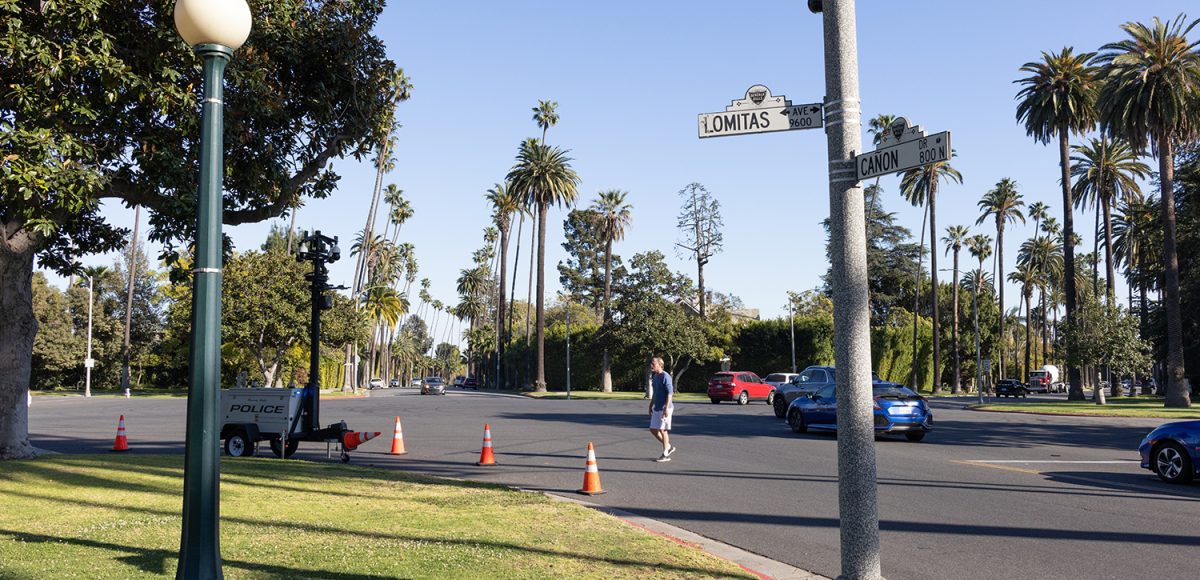On any given day, especially around rush hour, as many as 10 cars saddle up to the limit lines at the six-way intersection at Lomitas Avenue and Canon Drive. A delicate and dangerous game of chicken plays out, with drivers creeping out into the crossroads, side-eying the other vehicles, before either gunning it or snailing it to the other side. The intersection, the second largest in the city, has earned an international reputation as something of a vehicular crucible – a perplexity of city planning.
But the intersection found itself in the news once again last week when around 100 cars descended on the spot, blocking off the roads and performing donuts for an audience of 150 people, according to police reports. The “vehicle takeover”– the largest the city has ever seen – resulted in multiple arrests by the Beverly Hills Police Department.
On March 1, the City Council took yet another look at the infamous intersection and heard updates on possible corrective actions the city could take.
“It is pretty notorious,” said City Engineer Daren Grilley at the Council’s Regular Session. “If you do a simple Google search, you’ll see that it’s famous around the region, and even internationally, people comment on it.”
While the intersection has found its way before city officials multiple times over the last two decades, Grilley said that it has a surprisingly low collision rate. From 2015 to 2020, less than two dozen collisions were reported at the location. That, however, does not make it a good intersection, Grilley said.
“Good intersectional design doesn’t raise your blood pressure as you get close to it. So, while the collision rates may be low, there’s opportunities that are where we can make some improvements,” he told the Council.
A consultant for the city is currently studying the feasibility of a roundabout at Lomitas and Canon. Grilley differentiated a roundabout from a traffic circle as having “more advanced features that have been refined to make the traffic flow smoothly” and improve pedestrian safety.
“It’s actually quite interesting that the roundabouts that have been designed in the last 20 years match very closely with this intersection geometry that was laid out 115 years ago,” Grilley said.
The city could also consider ways of making the intersection more intuitive by “improving the geometry” to take away the guessing game from who has the right of way.
“It’s a daunting intersection,” said Councilmember Lester Friedman.
“It’s easy at a four-way intersection to keep track of who got there first and yielding to the vehicle on the right and things like that,” Grilley said.
Assigning right of way becomes tricky, however, when you have six intersections to keep track of. Add to that, drivers tend to treat Canon and Beverly as two-lane roads due to their width when they are, in fact, single lane roads. That means there’s as many as 10 cars at the intersection at a time.
Grilley pointed out that there are two other six-way intersections by Will Rogers Park. Canon and Lomitas, the largest of the three, is the only one without signals.
Vice Mayor Lili Bosse raised alarms about the risk to pedestrians at the Canon-Lomitas intersection, which has no sidewalks at the intersection itself. (“Apparently for aesthetic reasons,” Grilley explained.)
“I also feel like I’m playing chicken with the cars when I’m walking, because there is no designated sidewalk whatsoever to cross north or south or east or west,” she said.
Grilley did not have data for pedestrian-involved collisions at the intersection, but he assured Bosse that the considerations of a potential redesign would take into account pedestrian safety.
The conversation around the intersection and the vehicle takeover elicited broader concerns about driver behavior in the city since the coronavirus pandemic.
Todd Johnson, President and CEO of the Beverly Hills Chamber of Commerce, wrote in to the meeting that businesses around the city had seen troubling driving behavior lately.
“The Chamber is seeing and hearing more reports from local businesses of very loud cars and motorcycles driving through commercial streets, while others are driving at excessive speeds and creating a danger to themselves and pedestrians,” Johnson said.
Data since the start of the pandemic has indicated an alarming trend in pedestrian fatalities. Mayor Robert Wunderlich cited sobering preliminary data from the Governors Highway Safety Association that pedestrian fatalities rose 21% in 2020 even as pandemic-related restrictions and work-from-home orders kept more cars off the road.
“That’s a huge increase,” he said. “This is a health and safety issue.”
As the Council turns its attention to the issue in the coming months, Grilley stressed one tool in the city’s toolbox.
“Street design has a role to play in how people drive and the speeds that they drive,” he said.







